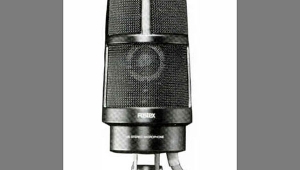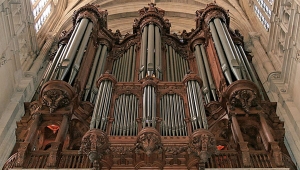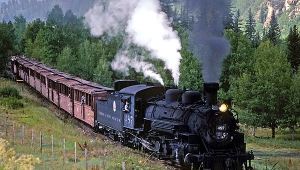| Columns Retired Columns & Blogs |
Workin' on the Railroad Page 3
I had mentally marked three locations from where I could get great shots when the train hove into sight. But I was requested not to move when recording began, because "the mike is so sensitive, it will pick up rustling-grass sounds when you move." I selected what I felt to be the best spot, and vowed that I would stay put. (I lied.)
Footnote 4: The tender is an open-top car attached to a locomotive, which carries coal for the furnace and water for the boiler. It "tends to" the locomotive's nutritional needs. I cannot resist posing an ancient riddle. Q: Why can't a locomotive sit down? A: Because it has a tender behind.
Finally, barely perceptibly, we heard the train whistle as it left the Chama station, almost 5 miles away. Many minutes later we heard it again, still a long way off. Joe didn't move. Again the whistle, a little closer still, this time followed by the slightest continuous sound of something else. Immediately, I saw Joe start the recorder, and I froze in place. I was, of course, standing right in a dense clump of dry grass. That continuous sound soon resolved itself into a familiar huff-chuffing, and I saw clouds of gray and white smoke billowing into the air from behind a distant bluff. Still, most of what I was hearing was an occasional grasshopper, the gentle rustle of windblown leaves and grass, and a bumble bee lazily circling my ankles. Then the whistle sounded again, but distinctly closer this time, and followed by an impressive echo from the far left, where a row of hills towered above the distant highway. The site had been well chosen.
Then the whistle started blowing in earnest, each blast following before the echoes from the last had died. The train stopped on the other side of the trestle while they were uncoupled, then the lead locomotive slowly crossed the trestle and stopped just beyond Joe and his equipment setup. It was still about a hundred yards from me, but already the racket was impressive. I knew that, now, there was no way that sensitive microphone 10 feet in front of me would "hear" rustling grass. Watching Joe, who was facing the other way, for any sign that he had heard a rustle through the headphones, I moved away from the mike, made a wide loop over and down the hillside, and stretched out on my belly right beside the track between Joe and the front of the first engine. I put the wide-angle lens on the camera.
Finally, the train started again and approached from behind me, audibly gaining speed with each second. I framed the picture I wanted, with Joe and his equipment at the right and the train at the left, and held the camera still, waiting for the train to appear and hoping it wouldn't loom too high above the camera's field of view. As the first locomotive passed by me, the ground began to heave with bone-jarring shocks, and I found myself pelted with cinders from the smokestack, some of them still red-hot. The noise was unbelievable; almost frighteningly loud. Then I saw the locomotive through the viewfinder, waited until it occupied about half the frame width, and fired off the shot.
When the incredible din started to fade, I assumed my frozen stance again. Then, just when the whistle blasts had almost vanished behind the distant hills, I heard a remarkable thing. One short toot, barely audible as it happened, was followed by an echo that must have been at least twice as loud and sounded half as far away. I could tell by the mutely jubilant look on Joe's face that it was exactly the kind of thing he was after. A minute or so later, I got the Tape's Stopped signal. "We got it!" said Joe. "It was perfect, except for a bee that kept buzzing the mike."
The hike back to the car was not as much fun as the one to the site, because the opposite of all-downhill is all-uphill. I am 56 years of age, I get little exercise, and I smoke a lot. But, miraculously, I did not get out of breath. What I did run out of on the return trek was stamina. The VCR I carried no longer weighed 18lbs. It weighed 23, 32, and then 40, rapidly approaching 50. Now, 50lbs is almost half my body weight, and my leg muscles simply rebelled. After two brief rest stops, which helped but not much, I was obliged to hand the VCR to Joe. "What the Hell," I rationalized, "He would have had to carry the damned thing all the way in both directions if I hadn't been along." But I graciously relieved him of the 1-lb mike stand.
Our next stop was Cumbres. From there on, the track grades were much more gentle, so only one locomotive would be needed for the return trip. We watched while the lead locomotive was disconnected and backed onto a siding. A railman operated two switches, and the engine pulled off the siding and back onto the main track, this time facing towards Chama. It paused with its tender (footnote 4) next to a trackside water tank, and the trackman climbed up, pulled a large spout from the tank over an open trapdoor, and refilled the boiler supply with water.
Brad had arrived there before our party, and already had a mike set up 15 feet from the track, in the shelter of some bushes. The recording system was sprawled across the back seat of the Millers' car, and Patricia was now hovering over the VCR awaiting Brad's raised-arm circular wave which meant "Roll tape!" The single locomotive was recorded departing. (As it pulled away, I spotted one of the engineers leaning out of the cab and doffing his trademark cap as though to acknowledge audience applause.) Then we grabbed a delicious portable lunch, courtesy of the Niklases and of Brad's parents, who just happened to be camping in Chama when the recording took place.
For the third pair of recordings, we schlepped the equipment along a mile or so of track from the Cumbres station into a heavily wooded area adjacent to a wide meadow, through which meandered a hairpin track turn (footnote 5) and a rising grade. Even in the shadow of the dense stands of spruce, there was enough breeze to make it necessary, again, to shield the microphones and place them low to the ground. At one site, inside the hairpin turn, the mike was placed about two feet above ground, on the leeward side of a large stand of trees facing the valley from which the train would approach. And because the now-solid overcast was threatening to dump some rain on us, Joe and Sarah set up the rest of the equipment under the largest and highest of the nearby spruces. (They had brought along plastic covers for the equipment, just in case, but nothing to keep themselves dry.)
I saw no promise of interesting photos here, so I went back to the other site. This one was near the top of the grade above the hairpin, where a steep embankment falling away from the railbed would allow me to get below the track level to shoot the approaching train from a very low perspective, to enhance the impression of its size. Here, the mike was placed about 20 feet back into the trees below track level. The processor and VCR, manned by Brad's wife Patricia (she doesn't care to be called Patricia), were about 8 feet from the track. Even before the recorder started rolling, we had an inkling that this session might not turn out all that propitiously.
Barely a minute after we heard the first distant whistle, the sound of a high-flying jet plane started intruding, growing slowly enough in volume that we knew it was going to last a long time. Miraculously, it had faded to inaudibility before the chuffing of the locomotive became (barely) audible and Patricia started the tape rolling. Then, just as the locomotive was becoming clearly audible, what sounded like a trailer truck with a defective muffler went roaring across the highway a mile or so away. It drowned out the train for several seconds, but Patricia let the VCR continue recording anyway.
Everything then went splendidly until the train passed our setup location. Many of the passengers waved, and we waved back, and then the last car passed. It was one of those old-fashioned "observation" cars, with the rear balcony from which generations of politicians used to do their stumping during "whistle-stop" campaigns. This observation car, though, contained a group of tourists who had apparently been celebrating ever since the train left Chama that morning, and were now feeling loudly exuberant. Not content to wave demurely, they cheered us rousingly as they passed. Scratch one "ambient" recording of a passing train!
The other team had been more fortunate. Because they had sought shelter from the rain that never materialized, they were never spotted by the observation-car revelers, who were at that moment silently appreciating the scenery. So at least most of one tape was usable.
It was time to fold up again. Observing that the entire return trip was uphill again, and having learned my limitations, I graciously offered this time to carry a pair of mike cables and one of the mike stands, and thus arrived back at the car in something less than a state of complete physical collapse.
Since I had never once spotted the becabbed Brad during any of the train passes, I asked if we could get a final shot, back at the rail yard, of him doing his cab thing. There just happened to be a locomotive standing furnace-cold and unoccupied in front of the engine house. Brad grabbed a mike, climbed up into the cab, held the mike out the window, and gave me a big grin. "No, no," I protested. "I'm not here, remember? Don't look at me, look to the horizon ahead, where the track disappears around the bend toward that distant world of romance and adventure." He gave me a strange look (Are you kidding?!), but complied. I took the picture, and that was it.
Postscript
Several days later, Brad, Patricia, and one of the mobile systems visited us in Santa Fe, and we thought it might be enlightening to listen to some of the tapes they had just made, as well as a few older ones Brad had brought along. We started in my main listening room, where the Sound Lab A-3s had been (temporarily) backed up with the small Technics wall-mount speakers I usually use in my video room for Dolby surrounds. That system, which I have found to be eminently satisfying for music reproduction, was hopelessly inadequate for reproducing trains, close aircraft passes, and fire engine sirens recorded from a distance of 15 feet. Not only did it give up in despair at volume levels far below what were necessary, it was also conspicuously deficient in that bottom octave (20–40Hz) that is apparently needed to reproduce the earthborne thuds of heavily-loaded steel wheels on a trackbed. We moved everything to the video room.
There, I had a pair of ">Watkins WE-1-II speakers up front, and with these (and a 200Wpc Perreaux 2150 power amp) we were able to listen at more realistic levels (clocked at 108dB on one occasion) and to get an inkling of the floorshaking low end we should have been reproducing but still weren't. We might have been able to get more level from the system than we did, but since I own the Watkinses, I was afraid to try (although they did manage to survive a humongous BANG that was recorded on one tape when someone plugged in the microphone while the tape was rolling).
It was clear, though, that had I been seeking for these past years a system to reproduce big, natural sounds rather than music and dialog, I would have ruled out "perfectionist audio" systems early in the game. This brought home to me, as never before, the fact that there is not—and perhaps cannot be—any one system that will reproduce all kinds of sounds with equal faithfulness. Does this mean, then, that true "high fidelity" sound reproduction is, in fact, an impossible goal? I'll have to think about that one. Some other time.
Footnote 4: The tender is an open-top car attached to a locomotive, which carries coal for the furnace and water for the boiler. It "tends to" the locomotive's nutritional needs. I cannot resist posing an ancient riddle. Q: Why can't a locomotive sit down? A: Because it has a tender behind.
Footnote 5: The Tanglefoot Curve, 1–1/2 miles East of Cumbres station.
- Log in or register to post comments























